This is part one of a three-part series about the building blocks of newsroom transformation. The second and third part of the series will be published later this month. Last year, Lisa MacLeod (our Director & Head of EMEA) wrote about the power of digital newsroom transformation in helping drive revenue and subscription growth for publishers. In this blog post we’ll look at why ‘Bridge Roles’ are paramount in unlocking this growth. Subscribe to FT Strategies’ newsletter to be the first to find out about new resources, upcoming programmes and case studies to help grow your business in 2024.
Long gone are the days of the late 90s and early 2000s when news publishers (including broadcasters) were enormous beneficiaries of advertising spend, and newspapers or TV bulletins were the core media products for audiences worldwide. It was also a time when commercial and editorial teams typically worked in siloes, never interacting with one another for fear of stories being steered by commercial interests. This working relationship became synonymous with the news industry, the well-entrenched concept of “church vs state”.
In 2024, the picture is different. Advertising money has dried up for news media, and competition for attention has intensified across new formats, platforms and creators. And yet despite this, the siloed work culture between teams still exists — sometimes to the detriment of revenue growth.
Moving past “us and them” mentality
Lisa has worked with hundreds of publishers over the past three years at FT Strategies and notes how too often the “damaging us and them mentality” between commercial and editorial colleagues (represented through the purple versus blue bubbles in the image below) hampers innovation and new strategic thinking, especially in a world where a closer connection to audiences is paramount.
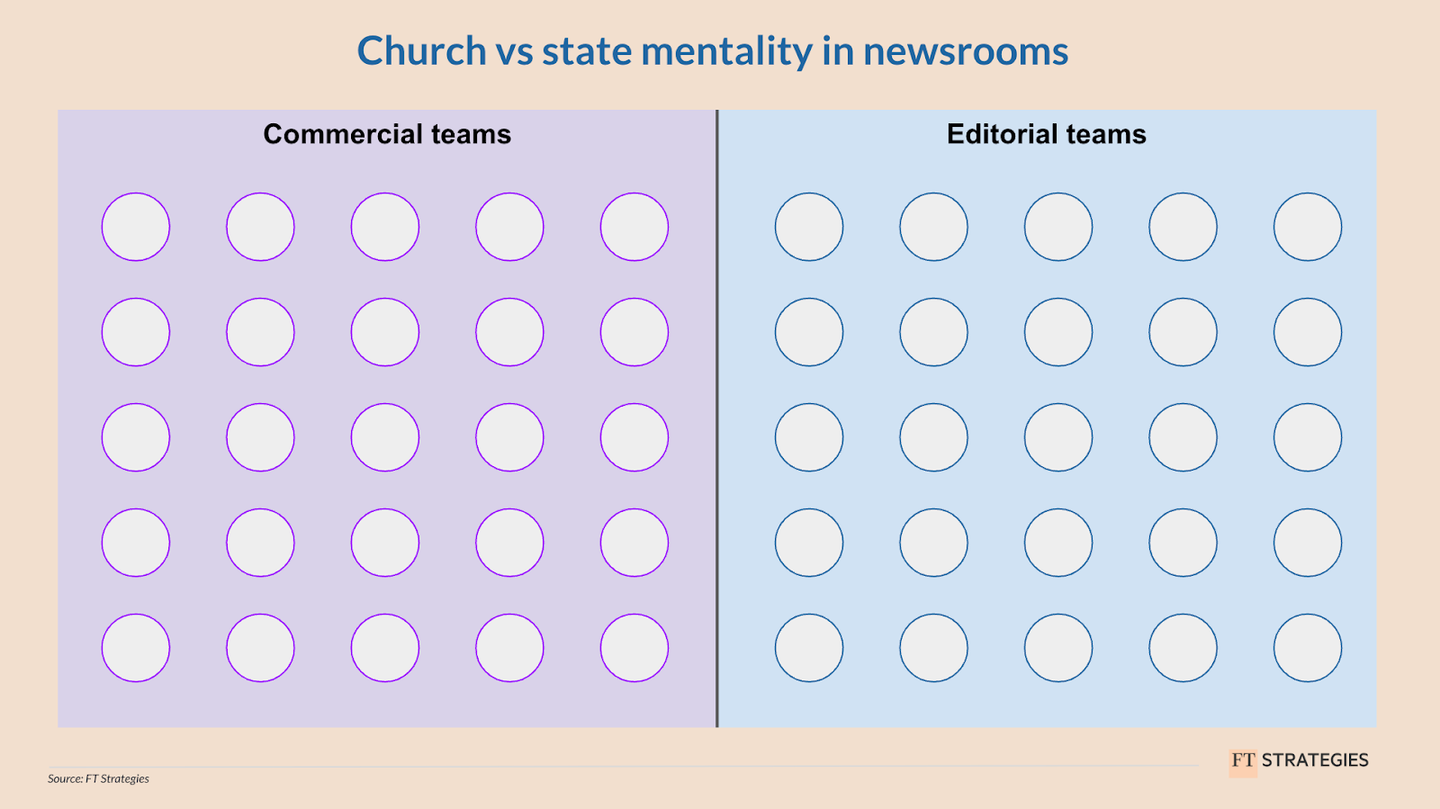




In this scenario, commercial colleagues come up with commercial strategies, such as lucrative verticals, cross-sell partnerships or new formats, in isolation before trying to get their editorial colleagues on board to implement them. Not only is this slow and hard to get through — no-one wants to be handed a fully-formed idea and told to "make it happen" — but the product often could be improved with expertise from around the business. When journalists are empowered to think strategically, they are often the very ones ideating new products, verticals, audience needs, formats, partnerships, events/community-building opportunities, and more.
So how do you empower teams to break down these siloes? New roles — with new responsibilities — can help bring about that transformation. These are often described as ‘Bridge Roles’, multi-disciplined team members who through excellent project and people management skills help connect siloed teams to work on strategic priorities (Journalism.co.uk; Robin Kwong, formerly at The FT as Special Projects Editor, one of the original Bridge Roles). They typically sit in teams that think deeply about the reader experience and interface with lots of different parts of a business like Audience, Product, Data, and Design.
It’s why a lot of the most exciting Bridge Roles in the industry all have some form of newsroom background: for example, Lauren Eddy (Senior Director, Audience & Editorial Strategy at NYT), Kevin Dubouis (Director of Content Strategy at WSJ), Ryan Kellett (VP of Audience at Axios), or our very own Hannah Sarney (Editorial Product Director at the FT). By understanding the workflows/pressures of newsrooms that they operate alongside, they can more effectively communicate and connect with journalists to bring about business impact.
In the image below, Bridge Roles are represented by the orange bubbles and represented within project teams that exist across the FT. These orange bubbles often create cross-functional teams that bring together the talent and skills from around the organisation in pursuit of an end goal (e.g. reduce subscriber churn).
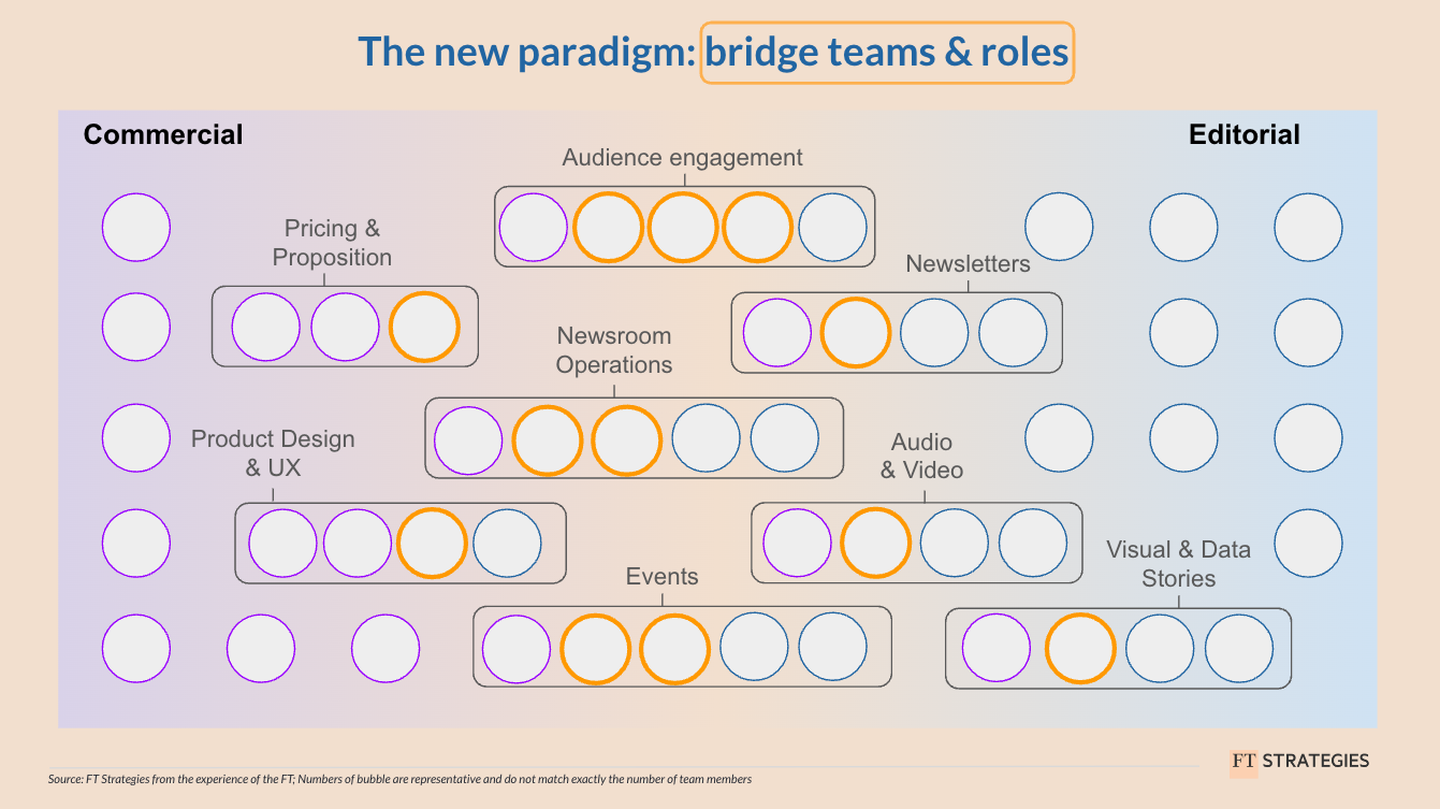




A role whose time has come?
While these ‘orange bubbles’ have existed in some form in newsrooms for over a decade, leading experts within the news ecosystem believe this year is a fundamental one for Bridge Roles. Look no further than this year’s NiemanLab Predictions:
- Robin Kwong says that “strong project management makes newsrooms more adaptable and more able to survive industry turmoil” (Prediction: Newsrooms (re)discover the magic of project management)
- Alexandra Borchardt explained how there are two phenotypes in newsrooms, the “content” people versus “the rest”, but with the advent of GenAI it's time to bridge these divides to super-serve audiences. (Prediction: Everyone in the newsroom gets training)
- Felicitas Carrique noted that news product management is “no longer a niche” and “news product thinkers are the ones who can connect the dots between technology, journalism, and business” (Prediction: News organisations will support product leadership)
- Dmitry Shishkin believes that the generalist times are over, and by embedding new User Needs strategies the industry can “finally connect newsroom output with its mission statements, providing much needed distinctiveness”. (Prediction: User-centric editorial models embrace empathy and scale)
As you can see, the value of Bridge Roles comes in the ability to connect disciplines in service of the reader, particularly when it comes to growth and audience development. This is especially important at a time when off-platform growth through referral traffic from search, platforms and social media becomes trickier to maximise in 2024, and therefore growth on owned-platforms becomes necessary (Journalism, Media, Technology: Trends & Predictions 2024, Reuters Institute). Proceeding too far down the wrong path or chasing readers in the wrong places has consequences that Bridge Roles try to minimise.
This is all especially important considering how difficult news publishers find it to attract and retain Product, Audience, and Design talent, one of the long-standing problems of our industry (Changing Newsrooms 2021, Reuters Institute). By doubling-down on upskilling, bringing in, and overall embedding Bridge Role type skills explained above, news publishers can give talent a clearer purpose and therefore increase job satisfaction.
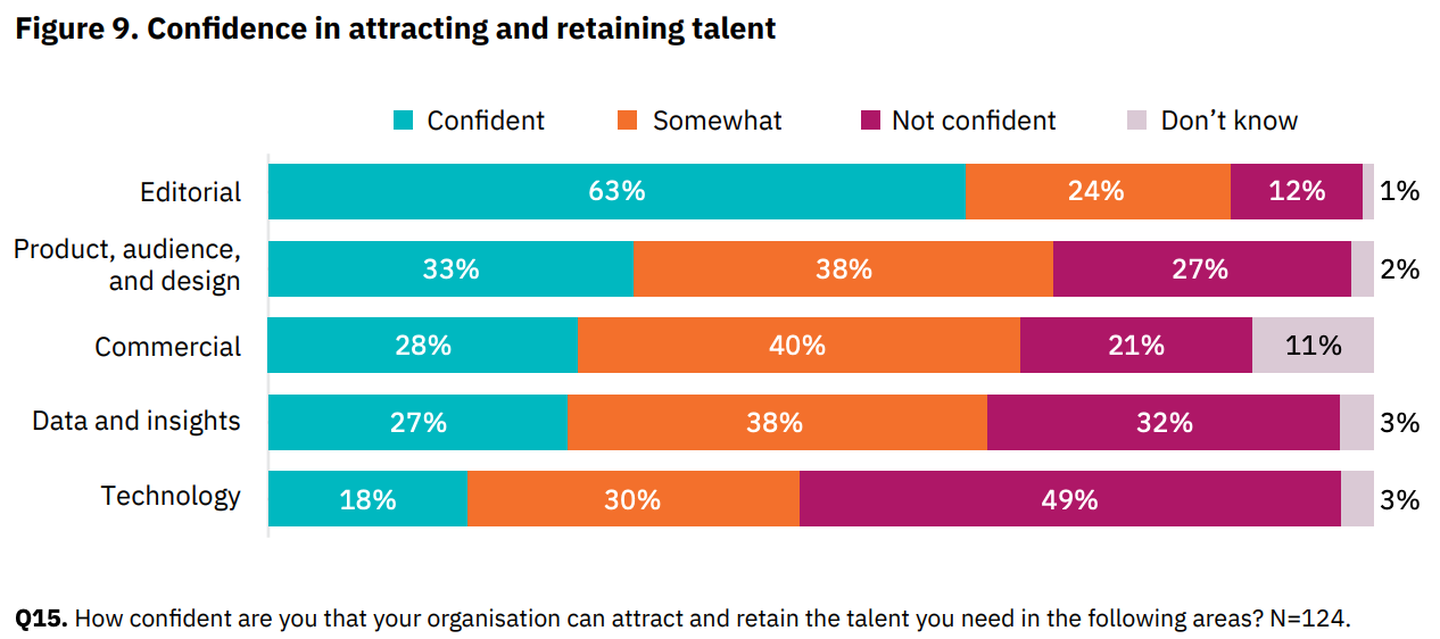




So what key attributes do these ‘orange people’ or Bridge Roles have?
One way to understand the value that Bridge Roles bring to an organisation is by looking at the FT Strategies ideal editorial workflow flywheel. The flywheel showcases the three core phases in any newsroom from content planning and creation, to packaging and distribution, and finally tracking/learning/preparing.
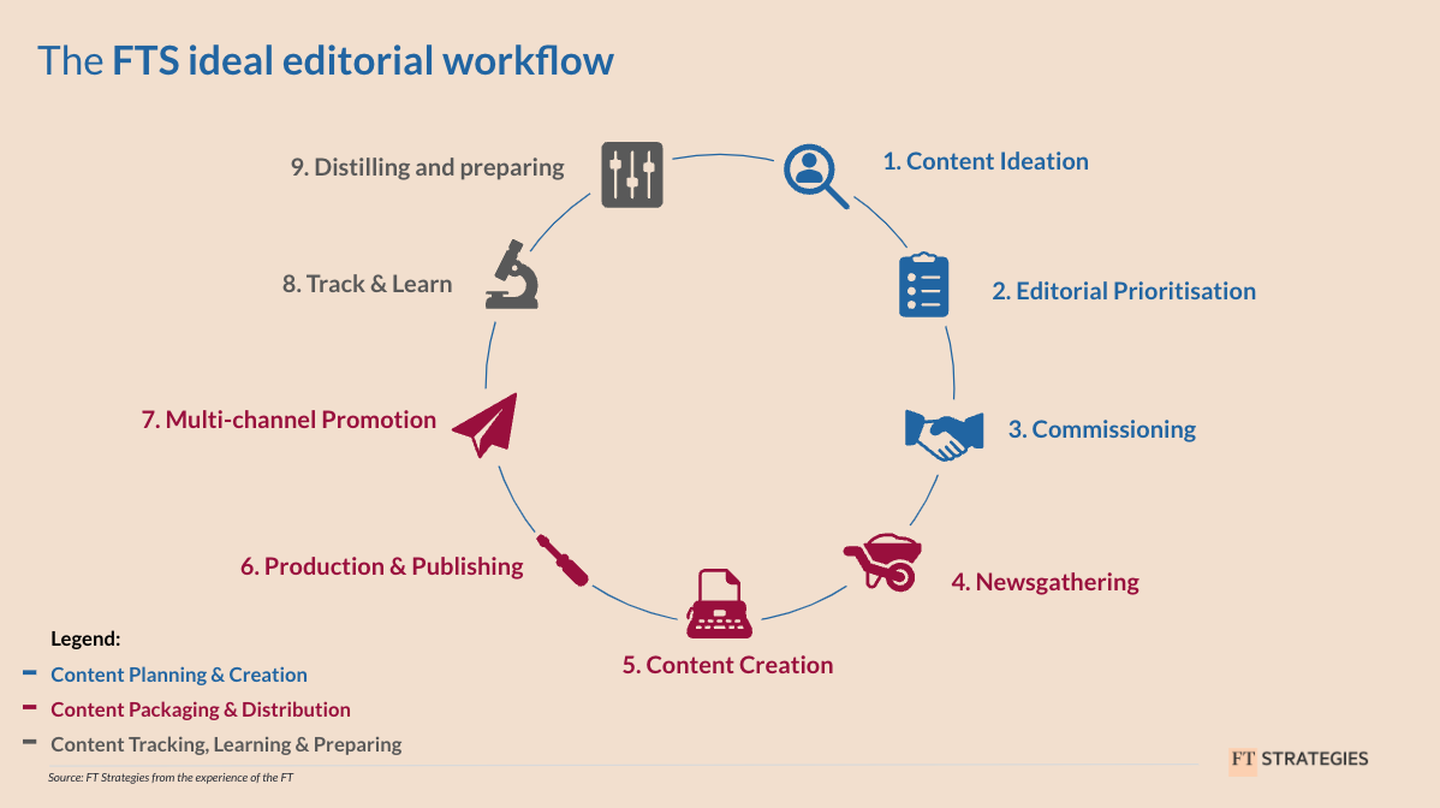




In our experience of working with 700+ publishers, newsrooms often struggle to complete step 8 and step 9 in the flywheel, which involves distilling the performance of content both quantitatively (by looking at audience site/engagement behaviour) and qualitatively (by looking at sentiment/conducting surveys), and feeding insights back into key editorial daily/weekly meetings.
The difficulty is that the day-to-day operations of newsrooms means this process is hard to get right, which leads to over-reliance on ‘gut’ feeling and some heel-dragging in attempts to understand content performance over the long-term. In turn, this compromises the newsroom’s ability to plan and commission content that is informed by audience data.
At the Financial Times, the role that best embodies these qualities is the Head of Audience Engagement (AE) Team, previously Hannah Sarney and now Charlotte Seager. As the head of a ten person, this role works extremely closely with newsroom and data teams, to help manage medium-to-long term initiatives for trialling new engagement tactics or content verticals. Ultimately, it also helps connect product and commercial teams with these initiatives to break down siloed efforts, create a culture of collaboration, and test new hypotheses. During an important period of subscriber growth at the FT, the AE team has overseen some key initiatives around Communities, Audience Diversity, and Social Media Development (as shown below).
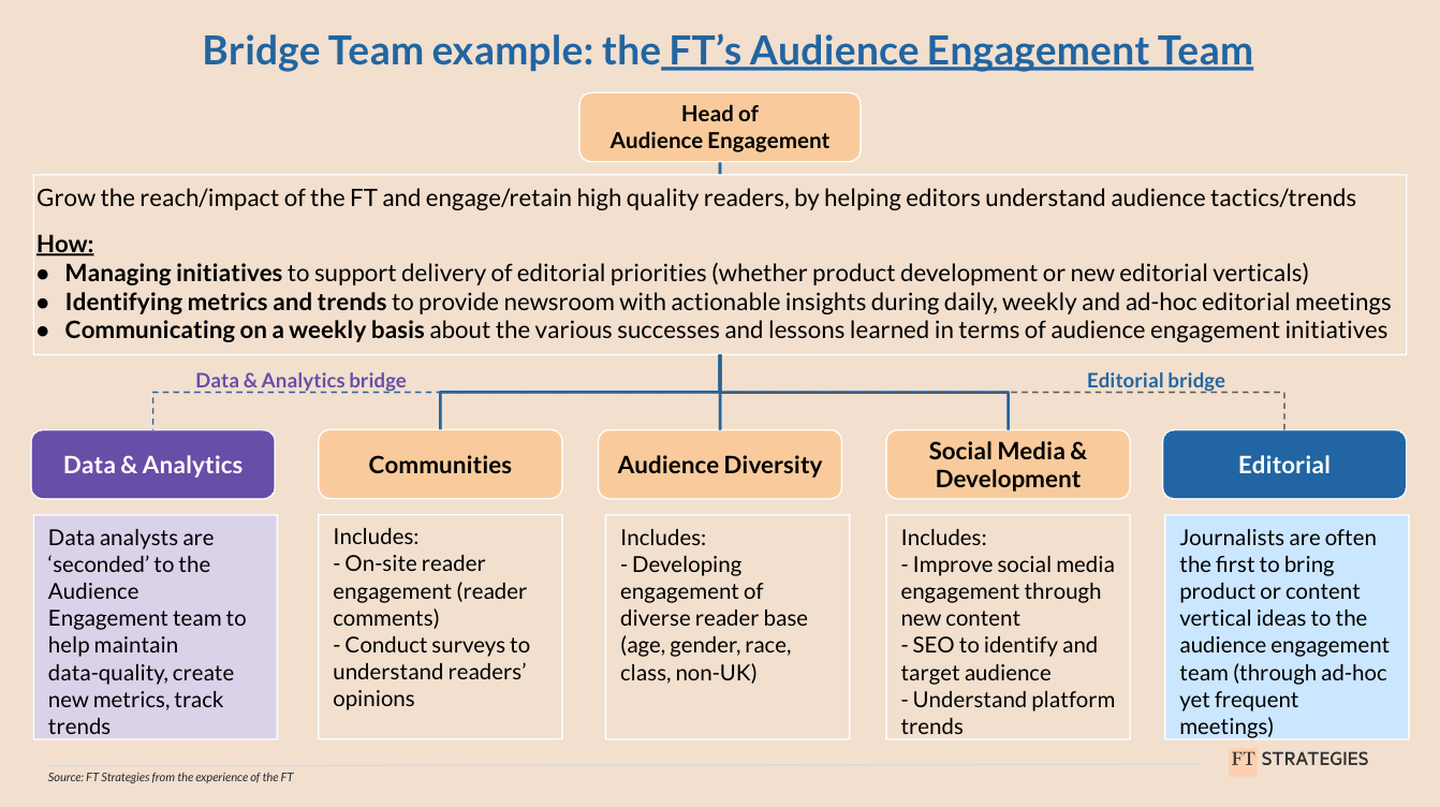




Overall, the AE team has also greatly boosted the adoption of a digital and data-informed mindset in the newsroom. The FT has for example doubled-down on its focus on quality rather than quantity to improve audience engagement, by producing more in-depth articles, explainers, and increasing the use of data visualisations and/or visual storytelling techniques, amongst a variety of other tactics.
Ultimately, there are a number of key attributes needed for ‘the orange people’ or Bridge Roles to succeed:
- Set clear and common goals that are documented and clearly communicated across departments in easily translatable language, to garner alignment
- Be laser-focused on listening to audiences, usually in part from a background in audience development, product, data & analytics, and/or SEO
- Utilise strong people management skills and experience in Editorial to specifically unlock the newsroom into more creative thinking that looks at the long-term over short-term
- Spin up ‘project teams’ by working closely with HR and/or operations teams, and provide a clear view of the group’s aims and timelines to other stakeholders
- Work with the data & analytics team to think creatively about the right metrics and quantitative audience research to take forward to understand reader engagement and value
- Have a keen eye on initiatives to sunset by understanding the power of lessons learned and failure, while keeping a positive experimental mindset within teams
In part 2 of this series we will speak to the outgoing Head of Audience Engagement, Hannah Sarney, about the qualities and skills needed to fulfil a Bridge Role and her new position as Editorial Product Director. In part 3 we’ll take a closer look at the FT’s Visual Stories & Investigations Editor, Sam Joiner, another ‘orange bubble’ or Bridge Role, that has helped the FT become world-leading in visual storytelling.
If you would like to learn more about how FT Strategies can help you transform your newsroom to become digital or audience-first, and also look at ways to create more agile teams around Bridge Roles, please do not hesitate to contact us here.
About the authors





Lamberto is a Senior Insights Consultant at FT Strategies and supports the ongoing building of media and subscriptions expertise. Prior to joining, Lamberto worked as a Research Analyst at Enders Analysis, where he focussed on the Publishing Industry and the need for radical digital transformation towards reader-first models. He holds an MSc in Media and Communications Governance from the London School of Economics and a Bsc in Politics and International Relations from the University of Bath.





Ben is a Manager at FT Strategies with extensive experience working with global publishers. He previously worked on the Audience Diversity Academy to help six EMEA publishers diversify their audience and build engagement among target segments. Prior to joining FT Strategies, Ben was an independent newsroom and content strategy consultant. He has ten years of experience in newsroom transformation and audience development from his time working at The Guardian and The Times.
